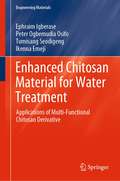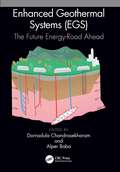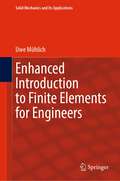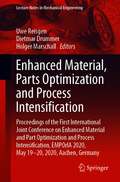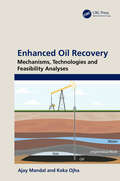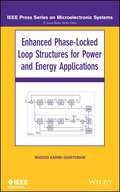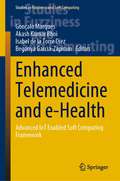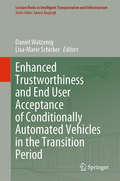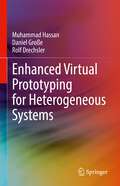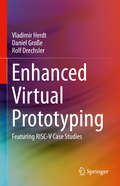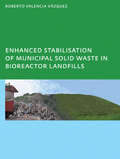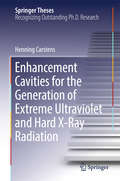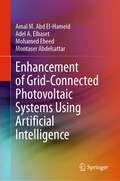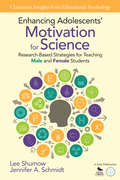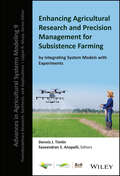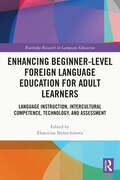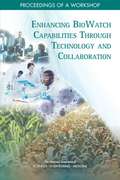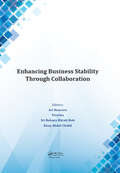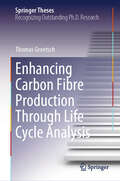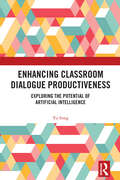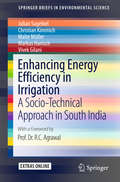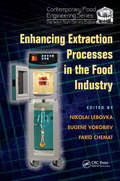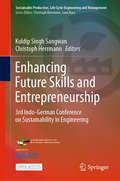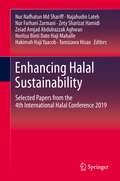- Table View
- List View
Enhanced Chitosan Material for Water Treatment: Applications of Multi-Functional Chitosan Derivative (Engineering Materials)
by Ephraim Igberase Peter Ogbemudia Osifo Tumisang Seodigeng Ikenna EmejiThis book reviews some of the latest developments in the field of water treatment using multi-functional chitosan-based materials. It covers the production of chitosan beads and membranes from chitosan powder, as well as modification techniques for enhancing the material for commercial and industrial purposes. The book summarizes the results of experimental adsorption/desorption studies for elucidating the underlying reaction mechanism of heavy-metal removal from wastewater, presenting an advanced overview of an array of characterization techniques such as Fourier-transform infrared spectroscopy, thermogravimetric analysis, x-ray diffraction, and scanning electron microscopy. Additionally, it features a look at the development and application of specialized engineering software and image analysis for modelling the kinetics of adsorption. This book is ideal for scientists and engineers working in the broader field of environmental materials science. It is all well suited for chemists, as well as industrial and civil engineers, interested in wastewater treatment and mitigation of water pollution
Enhanced Geothermal Systems (EGS): The Future Energy-Road Ahead
by Alper Baba Dornadula ChandrasekharamPeter Meisen, Past President, Global Energy Network Institute, asked in 1997, “What if there was an existing, viable technology, that when developed to its highest potential could increase everyone’s standard of living, cut fossil fuel demand and the resultant pollution?” After 23 years of sustained effort by the global scientific community, this is becoming a reality. The technology to extract heat from granite has been revolutionized in the last few years. The classical method of creating fracture networks by hydrofracturing is being replaced by a closed-loop method where fluids are not in contact with the hot granite. Supercritical CO2 is replacing water as a circulating fluid. Certainly, the future energy road is going to be led by highly radiogenic granites. While hydrothermal sources are site-specific and have their limitations, EGS can be initiated anywhere on earth. EGS is removing all such obstacles and, in the future, will provide uninterrupted electricity for all. Energy-deficient countries can have surplus electricity; water-stressed countries can have a perennial freshwater supply; and countries can become food-secure and rise above poverty levels. Countries need not depend on energy imports and can independently evolve into carbon neutral or low carbon societies. The contributions made by experts will help researchers and investors to close the energy demand and supply gap in the very near future by tapping the unlimited energy of the Earth. Opportunities available for investors in Turkey are well documented with field, geophysical, and geochemical data and information on the energy generating capacity of the granite intrusive spread over a cumulative area of 6,910 km2 in western Anatolia. With the signing of the Global Geothermal Alliance (GGA) by several countries during the December 2015 CoP 21 (Conference of Parties) summit in Paris, countries are obliged to reduce CO2 emissions by increasing the footprint of renewable energy in the primary source mix. Information provided in this book will lead the way to establishing a clean energy future for millions of people for sustainable development and help to mitigate crises arising due to food, water, and energy shortage issues. Academic and research institutes will benefit to a large extent from the expertise of the top contributors in this book. This information provided in this book will help to lay the foundation for super-hot EGS research in future.
Enhanced Introduction to Finite Elements for Engineers (Solid Mechanics and Its Applications #268)
by Uwe MühlichThe book presents the fundamentals of the Galerkin Finite Element Method for linear boundary value problems from an engineering perspective. Emphasis is given to the theoretical foundation of the method rooted in Functional Analysis using a language accessible to engineers. The book discusses standard procedures for applying the method to time-dependent and nonlinear problems and addresses essential aspects of applying the method to non-linear dynamics and multi-physics problems. It also provides several hand-calculation exercises as well as specific computer exercises with didactic character. About one fourth of the exercises reveals common pitfalls and sources of errors when applying the method. Carefully selected literature recommendations for further studies are provided at the end of each chapter. The reader is expected to have prior knowledge in engineering mathematics, in particular real analysis and linear algebra. The elements of algebra and analysis required in the main part of the book are presented in corresponding sections of the appendix. Students should already have an education in strength of materials or another engineering field, such as heat or mass transport, which discusses boundary value problems for simple geometries and boundary conditions.
Enhanced Material, Parts Optimization and Process Intensification: Proceedings of the First International Joint Conference on Enhanced Material and Part Optimization and Process Intensification, EMPOrIA 2020, May 19-20, 2020, Aachen, Germany (Lecture Notes in Mechanical Engineering)
by Uwe Reisgen Dietmar Drummer Holger MarschallThis book reports on topics at the interface between material processing, product and process optimization. It covers new developments and challenges in welding, brazing, cutting and coating, casting and molding, additive manufacturing, simulation and optimization techniques, as well as functional and structural materials and composites. Gathering authoritative contributions on the latest research and applications, presented at the International Joint Conference on Enhanced Material and Part Optimization and Process Intensification, EMPOrIA 2020, organized by SFB1120 Aachen, SFB814 Erlangen and CCE Darmstadt, on May 19–20, 2020, in Aachen, this book provides academics, students, and professionals with a timely snapshot of the main research trends, and extensive information on cutting-edge methods and technologies in materials, manufacturing and process engineering.
Enhanced Oil Recovery: Mechanisms, Technologies and Feasibility Analyses
by Ajay Mandal Keka OjhaOil recovery efficiency can be increased by applying the enhanced oil recovery (EOR) processes, which are based on the improvement of mobility ratio, reduction of interfacial tension between oil and water, wettability alteration, reduction of oil viscosity, formation of oil banks, and so forth. This book describes the different EOR methods and their mechanisms, which are traditionally used after conventional primary and secondary processes. The present scenario of different EOR processes, at both the field application stage and research stage, is also covered. Further, it discusses some of the recent advances in EOR processes such as low-salinity water flooding, the application of nanotechnology in EOR, microbial EOR, carbonated water injection, etc. Features: Comprehensive coverage of all enhanced oil recovery (EOR) methods Discussion of reservoir rock and fluid characteristics Illustration of steps in design and field implementation as well as the screening criteria for process selection Coverage of novel topics of nanotechnology in EOR and hybrid EOR method and low-salinity waterfloods Emphasis on recent technologies, feasibility, and implementation of hybrid technologies This book is aimed at graduate students, professionals, researchers, chemists, and personnel involved in petroleum engineering, chemical engineering, surfactant manufacturing, polymer manufacturing, oil/gas service companies, and carbon capture and utilization.
Enhanced Phase-Locked Loop Structures for Power and Energy Applications
by Masoud Karimi-GhartemaFilling the gap in the market dedicated to PLL structures for power systems Internationally recognized expert Dr. Masoud Karimi-Ghartemani brings over twenty years of experience working with PLL structures to Enhanced Phase-Locked Loop Structures for Power and Energy Applications, the only book on the market specifically dedicated to PLL architectures as they apply to power engineering. As technology has grown and spread to new devices, PLL has increased in significance for power systems and the devices that connect with the power grid. This book discusses the PLL structures that are directly applicable to power systems using simple language, making it easily digestible for a wide audience of engineers, technicians, and graduate students. Enhanced phase-locked loop (EPLL) has become the most widely utilized architecture over the past decade, and many books lack explanation of the structural differences between PLL and EPLL. This book discusses those differences and also provides detailed instructions on using EPLL for both single-phase applications and three-phase applications. The book's major topics include: A basic look at PLL and its standard structure A full explanation of EPLL EPLL extensions and modifications Digital implementation of EPLL Extensions of EPLL to three-phase structures Dr. Karimi-Ghartemani provides basic analysis that helps readers understand each of the structures presented without requiring complicated mathematical proofs. His book is filled with illustrated examples and simulations that connect theory to the real world, making Enhanced Phase-Locked Loop Structures for Power and Energy Applications an ideal reference for anyone working with inverters, rectifiers, and related technologies.
Enhanced Telemedicine and e-Health: Advanced IoT Enabled Soft Computing Framework (Studies in Fuzziness and Soft Computing #410)
by Akash Kumar Bhoi Gonçalo Marques Isabel de la Torre Díez Begonya Garcia-ZapirainIn recent years, new applications on computer-aided technologies for telemedicine have emerged. Therefore, it is essential to capture this growing research area concerning the requirements of telemedicine. This book presents the latest findings on soft computing, artificial intelligence, Internet of Things and related computer-aided technologies for enhanced telemedicine and e-health. Furthermore, this volume includes comprehensive reviews describing procedures and techniques, which are crucial to support researchers in the field who want to replicate these methodologies in solving their related research problems. On the other hand, the included case studies present novel approaches using computer-aided methods for enhanced telemedicine and e-health. This volume aims to support future research activities in this domain. Consequently, the content has been selected to support not only academics or engineers but also to be used by healthcare professionals.
Enhanced Trustworthiness and End User Acceptance of Conditionally Automated Vehicles in the Transition Period (Lecture Notes in Intelligent Transportation and Infrastructure)
by Daniel Watzenig Lisa-Marie SchickerA key factor for the introduction of (conditionally) automated vehicles is a high level of trust in and acceptance of these vehicles by the end-user. To bring such so-called TrustVehicles on the road, the end-users and their expectations have to be strongly taken into consideration by, for instance, developing driver interfaces as well as reliable and robust automated driving controllers. The main topics of the book are ranging from the question of how these TrustVehicles should behave and interact with users, the development of reliable sense-plan-act approaches, the whole verification procedures starting with simulation to studies on the driving simulator and the verification on a test track. All these steps together provide an overall picture and pave the way to trustworthy and reliable automated vehicles – so-called TrustVehicles.
Enhanced Virtual Prototyping for Heterogeneous Systems
by Rolf Drechsler Daniel Große Muhammad HassanThis book describes a comprehensive combination of methodologies that strongly enhance the modern Virtual Prototype (VP)-based verification flow for heterogeneous systems-on-chip (SOCs). In particular, the book combines verification and analysis aspects across various stages of the VP-based verification flow, providing a new perspective on verification by leveraging advanced techniques, like metamorphic testing, data flow testing, and information flow testing. In addition, the book puts a strong emphasis on advanced coverage-driven methodologies to verify the functional behavior of the SOC as well as ensure its security.Provides an extensive introduction to the modern VP-based verification flow for heterogeneous SOCs;Introduces a novel metamorphic testing technique for heterogeneous SOCs which does not require reference models;Includes automated advanced data flow coverage-driven methodologies tailored for SystemC/AMS-based VPs;Describes enhanced functional coverage-driven methodologies to verify various functional behaviors of RF amplifiers.
Enhanced Virtual Prototyping: Featuring RISC-V Case Studies
by Rolf Drechsler Daniel Große Vladimir HerdtThis book presents a comprehensive set of techniques that enhance all key aspects of a modern Virtual Prototype (VP)-based design flow. The authors emphasize automated formal verification methods, as well as advanced coverage-guided analysis and testing techniques, tailored for SystemC-based VPs and also the associated Software (SW). Coverage also includes VP modeling techniques that handle functional as well as non-functional aspects and also describes correspondence analyses between the Hardware- and VP-level to utilize information available at different levels of abstraction. All approaches are discussed in detail and are evaluated extensively, using several experiments to demonstrate their effectiveness in enhancing the VP-based design flow. Furthermore, the book puts a particular focus on the modern RISC-V ISA, with several case-studies covering modeling as well as VP and SW verification aspects.
Enhanced stabilisation of municipal solid waste in bioreactor landfills: UNESCO-IHE PhD Thesis
by Roberto Valencia VazquezMunicipal solid waste entombed in landfills will produce pollution in the form of landfill gas and leachate when the barriers fail in the long term. Bioreactor landfills are an alternative solution to avoid such negative impacts and to achieve a more stable residue, the so-called Final Storage Quality (FSQ) of residues. However, until now the main
Enhancement Cavities for the Generation of Extreme Ultraviolet and Hard X-Ray Radiation (Springer Theses)
by Henning CarstensThis thesis discusses the power scaling of ultrashort pulses in enhancement cavities, utilized in particular for frequency conversion processes, such as Thomson scattering and high-harmonic generation. Using custom optics for ultrashort-pulse enhancement cavities, it demonstrates for the first time that at the envisaged power levels, the mitigation of thermal effects becomes indispensable even in cavities comprising solely reflective optics. It also studies cavities with large beams, albeit with low misalignment sensitivity, as a way to circumvent intensity-induced mirror damage. Average powers of several hundred kilowatts are demonstrated, which benefit hard x-ray sources based on Thomson scattering. Furthermore, pulses as short as 30 fs were obtained at more than 10 kW of average power and employed for high-harmonic generation with photon energies exceeding 100 eV at 250 MHz repetition rate, paving the way for frequency comb spectroscopy in this spectral region.
Enhancement of Grid-Connected Photovoltaic Systems Using Artificial Intelligence
by Adel A. Elbaset Amal M. Hameid Mohamed Ebeed Montaser AbdelsattarEnhancement of Grid-Connected Photovoltaic Systems Using Artificial Intelligence presents methods for monitoring transmission systems and enhancing distribution system performance using modern optimization techniques considering different multi-objective functions such as voltage loss sensitivity indexes, reducing total annual cost, and voltage deviation. The authors offer a comprehensive survey of distributed energy resources (DERs), explain the backward/forward sweep (BFS) power flow algorithm, and present simulation results on the optimal integration of photovoltaic-based distributed generators (PV-DG) and distribution static synchronous compensators (DSTATCOM) in different transmission and distribution systems. This book will be a valuable academic and industry resource for electrical engineers, students, and researchers working on optimization techniques, photovoltaic systems, energy engineering, and artificial intelligence.
Enhancing Adolescents' Motivation for Science: Research-Based Strategies for Teaching Male and Female Students
by Lee B. Shumow Jennifer A. SchmidtBecause motivation is the key to scientific literacy Within every science classroom there are students waiting to be inspired. All these students need is the right motivation. That’s exactly what this one-of-a kind guide will help you provide. And along the way, you’ll quickly learn that the motivational tools that are most effective with adolescent boys don’t always work with adolescent girls—and vice versa. Part book, part website, this resource • Details research-proven motivational constructs specific to science • Addresses gender differences that influence motivation • Describes how to make science learning relevant and enjoyable • Builds confidence, especially among girls • Offers motivational strategies that are consistent with the NGSS
Enhancing Agricultural Research and Precision Management for Subsistence Farming by Integrating System Models with Experiments (Advances in Agricultural Systems Modeling)
by Lajpat R. AhujaEnhancing Agricultural Research and Precision Management for Subsistence Farming Insightful applications of crop system models to developing countries to explore climate change mitigation and management decision tools Enhancing Agricultural Research and Precision Management for Subsistence Farming by Integrating System Models with Experiments delivers an authoritative collection of applications of crop system models to Asian and African environments and evaluates current agricultural systems in developing nations. The book provides models to assist in the precision management of soil, water, fertilizers and manures, soil organic matter, alternative crops, and cultivars in both rainfed and irrigated systems. Contributions cover recent and ongoing research in knowledge gap areas such as modeling the long-term effect of management soil health, the effect of extreme temperatures and drought on evapotranspiration and crop growth, root growth and the uptake of water and nutrients. The book also includes An introduction to system models integrated with experiments as tools to develop improved management practices for subsistence farming Explorations of models of soil erosion impacts and trade-offs for sustainable land management practices in Kenya Discussions of the crop simulation model as a tool to quantify the effects of crop management practices in northern Ethiopia In-depth examinations of models of water dynamics for assessing and managing ecosystem services in India Perfect for field research scientists and graduate students studying cropping and range systems, and essential reading for agricultural consultants, progressive farmers, plant breeders, and policymakers. Advances in Agricultural Systems Modeling Transdisciplinary Research, Synthesis, and Applications Lajpat R. Ahuja, Series Editor Agricultural system modeling has made substantial progress, but there are still many critical gaps in our knowledge. The American Society of Agronomy, Crop Science Society of America, and Soil Science Society of America are taking a leadership role with the initiation of this new series. Future breakthroughs in science and technology lie at the boundaries of disciplines. The new series will Advance critical transdisciplinary research, and its synthesis and quantification Encourage collaboration among top researchers in building and improving models Promote the application of system models to solve practical problems Achieve better instruction in these models and their applications
Enhancing Beginner-Level Foreign Language Education for Adult Learners: Language Instruction, Intercultural Competence, Technology, and Assessment (Routledge Research in Language Education)
by Ekaterina NemtchinovaThis book is an authoritative text that explores best classroom practices for engaging adult learners in beginner-level foreign language courses. Built around a diverse range of international research studies and conceptual articles, the book covers four key issues in teaching language to novice students: development of linguistic skills; communicative, and intercultural competence; evaluation and assessment; and the use of technology. Each chapter includes teaching insights that are supported by critical research and can be practically applied across languages to enhance instructional strategies and curriculum designs. The text also aims to build intercultural competence, harness technology, and design assessment to stimulate effective learning in formal instructional settings including colleges, universities, and specialist language schools. With its broad coverage of language pedagogy at the novice level, this book is a must read for graduate students, scholars, researchers, and practitioners in the fields of language education, second language acquisition, language teaching and learning, and applied linguistics.
Enhancing BioWatch Capabilities Through Technology and Collaboration: Proceedings of a Workshop
by Engineering Medicine National Academies of SciencesThe Department of Homeland Security’s (DHS’s) BioWatch program aims to provide an early indication of an aerosolized biological weapon attack. The first generation of BioWatch air samplers were deployed in 2003. The current version of this technology, referred to as Generation 2 (Gen-2), uses daily manual collection and testing of air filters from each monitor, a process that can take 12 to 36 hours to detect the presence of biological pathogens. Until April 2014, DHS pursued a next-generation autonomous detection technology that aimed to shorten the time from sample collection to detection to less than 6 hours, reduce the cost of analysis, and increase the number of detectable biological pathogens. Because of concerns about the cost and effectiveness of the proposed Generation 3 system (Gen-3), DHS cancelled its acquisition plans for the next-generation surveillance system. In response to the cancellation announcement, Congress asked the Government Accountability Office (GAO) to conduct a review of the program and the proposed system enhancements that would have been incorporated in BioWatch Gen-3. However, Mike Walter, BioWatch Program manager, Office of Health Affairs, DHS, said that DHS did not agree with all of GAO’s characterizations of the BioWatch program efforts described in this review. In response to this, DHS requested that the National Academies of Sciences, Engineering, and Medicine conduct a workshop to further explore the findings of the 2015 GAO report and discuss the impact these findings may have with regard to the future development of the technical capabilities of the BioWatch program. Workshop participants also discussed existing and possible collaborations between BioWatch, public health laboratories, and other stakeholders that could contribute to the enhancement of biosurveillance capabilities at the federal, state, and local levels. This publication summarizes the presentations and discussions from the workshop.
Enhancing Business Stability Through Collaboration: Proceedings of the International Conference on Business and Management Research (ICBMR 2016), October 25-27, 2016, Lombok, Indonesia
by Ari Kuncoro, Viverita, Sri Rahayu Hijrah Hati & Dony Abdul ChalidBusiness practices in emerging markets are constantly challenged by the dynamic environments that involve stakeholders. This increases the interconnectedness and collaboration as well as spillover effect among business agents, that may increase or hold back economic stability. This phenomenon is captured in this proceedings volume, a collection of selected papers of the 10th ICBMR 2016 Conference, held October 25—27, 2016 in Lombok, Indonesia. This ICBMR’s theme was Enhancing Business Stability through Collaboration, and the contributions discuss theories, conceptual frameworks and empirical evidence of current issues in the areas of Business, Management, Finance, Accounting, Economics, Islamic Economics, and competitiveness. All topics include aspects of multidisciplinarity and complexity of safety in research and education.
Enhancing Carbon Fibre Production Through Life Cycle Analysis (Springer Theses)
by Thomas GroetschThis book describes the application of life cycle assessment (LCA) methodology to streamline analysis of process and material variations in carbon fibre manufacturing, focusing on large-scale continuous production. It reports on a modular LCA concept based on accepted international standards and an in-depth analysis of carbon fibre manufacture. This streamlined assessment approach considers material flows and properties, and generated emissions, throughout the manufacturing process. Further, four manufacturing scenarios for optimizing material throughput are discussed, highlighting trade-offs between production rate, material properties, environmental impact, and cost. In turn (“Subsequently” or a synonym may be more suitable here as this part is not directly linked to what is described in the previous sentence), the evaluation of three precursor materials,traditional PAN, textile-grade PAN, and an experimental bio-based lignin-cellulose blend is described. The strengths and weaknesses, like processability and cost efficiency, of each material are outlined in detail. Overall, this book offers a comprehensive analysis of the effect process and material variations have on carbon fiber manufacture. It also showcases methodologies to optimize these industrial processes for a sustainable production on a large scale.
Enhancing Classroom Dialogue Productiveness: Exploring the Potential of Artificial Intelligence
by Yu SongThis book demonstrates how artificial intelligence (AI) can be used to uncover the patterns of classroom dialogue and increase the productiveness of dialogue.In this book, the author uses a range of data mining techniques to explore the productive features and sequential patterns of classroom dialogue. She analyses how the Large Language Model (LLM) as an AI technique can be adapted to enhance dialogue contributions. The book also includes valuable feedback and practical cases from teachers and their dialogue transcripts, facilitating an understanding of AI use and pedagogical development.This book makes original contributions to the field of classroom dialogue and technology, and it will encourage scholars making similar attempts at technological infusion for pedagogical improvement.
Enhancing Energy Efficiency in Irrigation
by Julian Sagebiel Christian Kimmich Malte Müller Markus Hanisch Vivek GilaniThis SpringerBrief reviews currently applied and potential solutions for improving the efficiency and quality of rural electricity supply in India, a major bottleneck for agricultural development. It provides background on the current state of supply and reviews recent and ongoing research and development projects. One selected project, designed and conducted by the authors, is outlined in detail. The research findings, project implementation, and evaluation are intended to provide development practitioners, policy makers, and applied researchers with experience from the field. At the core of this Brief is the integration of technical and social solutions, emphasizing the role of collective action, and the merits and demerits of small-scale, technically simple measures.
Enhancing Environmental Education Through Nature-Based Solutions (Integrated Science #4)
by Clara Vasconcelos Cristina S. C. CalheirosThis Book presents innovative and state of the art studies developed in Environmental Education in different countries to highlight this theme and promote its implementation all over the world. It will give a scientific perspective of Nature-based solutions to promote environmental education in all citizens and a more educational perspective as to how this approach can be implemented at schools and universities. Not less important is that includes science communication as a key factor for training and disseminating about the environment. The invited authors are recognized experts with excellent work developed in Environmental Education.This contributed volume presents innovative and creative work in the area giving a step forward in the implementation of Environmental Education, namely as a target of 2020 United Nations Agenda for Sustainable Development. The invitation of authors from many different countries allows the creation of a network and subsequently the book will bring concrete ideas as to how to develop operational capacities to bring added values to Environmental Education at an international level.
Enhancing Extraction Processes in the Food Industry (Contemporary Food Engineering)
by Eugene Vorobiev Nikolai Lebovka Farid ChematExtraction is an important operation in food engineering, enabling the recovery of valuable soluble components from raw materials. With increasing energy costs and environmental concerns, industry specialists are looking for improved techniques requiring less solvents and energy consumption. Enhancing Extraction Processes in the Food Industry is a
Enhancing Future Skills and Entrepreneurship: 3rd Indo-German Conference on Sustainability in Engineering (Sustainable Production, Life Cycle Engineering and Management)
by Christoph Herrmann Kuldip Singh SangwanThis open access book presents the proceedings of the 3rd Indo-German Conference on Sustainability in Engineering held at Birla Institute of Technology and Science, Pilani, India, on September 16–17, 2019. Intended to foster the synergies between research and education, the conference is one of the joint activities of the BITS Pilani and TU Braunschweig conducted under the auspices of Indo-German Center for Sustainable Manufacturing, established in 2009. The book is divided into three sections: engineering, education and entrepreneurship, covering a range of topics, such as renewable energy forecasting, design & simulation, Industry 4.0, and soft & intelligent sensors for energy efficiency. It also includes case studies on lean and green manufacturing, and life cycle analysis of ceramic products, as well as papers on teaching/learning methods based on the use of learning factories to improve students’problem-solving and personal skills. Moreover, the book discusses high-tech ideas to help the large number of unemployed engineering graduates looking for jobs become tech entrepreneurs. Given its broad scope, it will appeal to academics and industry professionals alike.
Enhancing Halal Sustainability: Selected Papers from the 4th International Halal Conference 2019
by Nur Nafhatun Md Shariff Najahudin Lateh Nur Farhani Zarmani Zety Sharizat Hamidi Zeiad Amjad Abdulrazzak Aghwan Norliza Binti Dato Haji Mahalle Hakimah Haji Yaacob Tomizawa HisaoThe global halal industry is likely to grow to between three and four trillion US dollars in the next five years, from the current estimated two trillion, backed by a continued demand from both Muslims and non-Muslims for halal products. Realising the importance of the halal industry to the global community, the Academy of Contemporary Islamic Studies (ACIS), the Universiti Teknologi MARA Malaysia (UiTM) and Sultan Sharif Ali Islamic University (UNISSA) Brunei have organised the 4th International Halal Conference (INHAC) 2019 under the theme “Enhancing Halal Sustainability'. This book contains selected papers presented at INHAC 2019. It addresses halal-related issues that are applicable to various industries and explores a variety of contemporary and emerging issues. It covers aspects of halal food safety, related services such as tourism and hospitality, the halal industry - including aspects of business ethics, policies and practices, quality assurance, compliance and Shariah governance Issues, as well as halal research and educational development. Highlighting findings from both scientific and social research studies, it enhances the discussion on the halal industry (both in Malaysia and internationally), and serves as an invitation to engage in more advanced research on the global halal industry.
